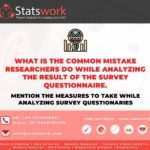What are the different qualitative data analysis methods? Mention the steps in qualitative data analysis.
In-Brief
Qualitative data collection and analysis tools provide the researchers with a detailed analysis of subject matters
- The questions asked by our team to collect qualitative data questions are open-ended, so respondents are free to express their opinions, that leads to more information
- Primary and secondary data in statistics our researchers tend to probe the participants and gather more information by asking the right questions to participants
Introduction
Qualitative data collection is the process that involves in-depth analysis and research.The Data analysis plan for qualitative research mainly focused on gaining insights and reasoning.
Qualitative data collection methods
- One-to-One Interviews:
One to one interview is the commonly used method to collect data—this method of data collection used for a small group of the subject on a broad range of topic. There are two types of interview structured and unstructured. A structured interview is comparable with questionnaires, with the same question in different order still get the unique outcome. Unstructured research question differs from each subject and entirely rely on multiple choice answers given on the previous question. An interview is not done face to face beside an on-call, video conference with the target participants. Qualitative data analysis service team of PhD data collection experts involves in the process ofcollection of original data.
- Focus groups:
A focus group discussion method is a Qualitative method of data collection where a selected group of individual allowed to discuss a given topic or issue facilitated by the external mediator. The group contain 6-10 members, and a mediator assigned for ongoing discussion. Depending on the sorted data, the group member will have something common.
There are two types of group one is a natural group which consist of multiple participants from a pre-existing informal or formal group. Second is the expert group consist of several people who have particularly good and broad expert knowledge and experience of the research topic.
- Record keeping:
Record keeping is the systematic recording of standardized information. It is nothing but keeping consistent record between data collectors and locations by having forms available with a specific question about the data collection.Record keeping is the method of documenting the reliable and similar source of information. Sample qualitative data analysis plan helps in keeping the old data as a reference to collect relevant data used for research.
- Process of observation:
An observation is a method used to gather knowledge of the already researched phenomenon by making observations. It is a systematic data collection method; for this, researchers use their sense to examine peoples nature occurring or settings. Process of observation involves engagement with the social situation. Qualitative data collection toolsservice helps to collect other documentation proofs such as video and audio recordings.
- Longitudinal studies:
The longitudinal study is the study where the research settings involve multiple follow up measurements on random samples.Analytical Tools for Qualitative Research service involves individuals achievement, performance, attitude over a while. This type of data collection methods is performed on the same data source repeatedly over some time. It is an observational research technique that goes for a few years. The ultimate aim to conduct this method is to find correlations through an empirical study of subjects with research traits.
- Case studies:
Case study data collection is an in-depth descriptive method about specific entities about the case data collected, interpreted, organized and presented in a narrative format. Statistical data analysis in qualitative market research helps in data is gathering through in-depth analysis of the case study—the strength of this method how it uses thecombination of one or more qualitative data to draw the inference.

Step involved in qualitative data analysis
- Arrange your data
Once after the collection, the data is highly unstructured and doesn’t make any sense before structuring. Therefore it is essential to first transcribe the data collected for the researcher’s understanding. Arranging it systematically gives a clearer view of data that helps in easy analyzing. Quantitative data analysis in business research helps in the process of exporting the data available into a spreadsheet or manual typing the data with the help of a computer-assisted qualitative analysis tool.
- Organize all your data
After transcribing and arranging the data next step is to organize your data. The aim of conducting this step is to organize the data in n orderly manner. The best way to organize the data is by knowing the main objective of the research and considering that prioritizing the needed data. The organizing step helps to access the data easily. The common type of organizing the data is by arranging them in a table, so it appears visually clear. Sampling design in qualitative research methodology will help you to include only the needed data for the information by excluding unrelated data that collected or you will end up wasting your time and money, and these types also lack inconclusive results.
- Set code to the data collected
Setting up proper codes for the different data takes you a step ahead in the analyzing process. Coding is the proper way to compress a tremendous amount of information at the same time. Coding the qualitative data means categorizing, assigning, and checking the patterns of the collected data. It is an important step in qualitative research, as this part entirely drives the research forward. To gain further in-depth insight research into the data can then begin to build patterns that will help to make informed information.
- Validate your data
Validating is the challenging process in Qualitative data analysis. Validating in qualitative research checked by the technique commonly called as respondent validation. This step involves testing an initial result with the participants. The validation is not just a one-step process; this is the recurring process that followed throughout the research.
There are two approaches invalidating data:
- The most significant in research is accuracy. So, the accuracy of the research design and method is essential.
- Reliability is the extent to which the methods produce accurate data constantly.
- Concluding the Analysis Process
It is essential always to terminate the process, which means systematically presenting your data that report are readily used. The report should include the method used for the research studies, positive and negative outcome of the research work and their limitations. In the report, you should always state the suggestions and inference of your findings also the related future research on the topic.PhD Dissertation Qualitative Data Analysis Help you to have an inference of your findings to increase the quality of the document.
Conclusion
Qualitative data collected helps the statistical data analysis in qualitative market research to understand the mindset of the customer. The application of qualitative data gives businesses an insight into why a customer purchased a product.
References
- Bailey, J. (2008). First steps in qualitative data analysis: transcribing. Family practice, 25(2), 127-131.
- Graue, C. (2015). Qualitative data analysis. International Journal of Sales, Retailing & Marketing, 4(9), 5-14.
- Mayer, I. (2015). Qualitative research with a focus on qualitative data analysis. International Journal of Sales, Retailing & Marketing, 4(9), 53-67.



 Previous Post
Previous Post Next Post
Next Post